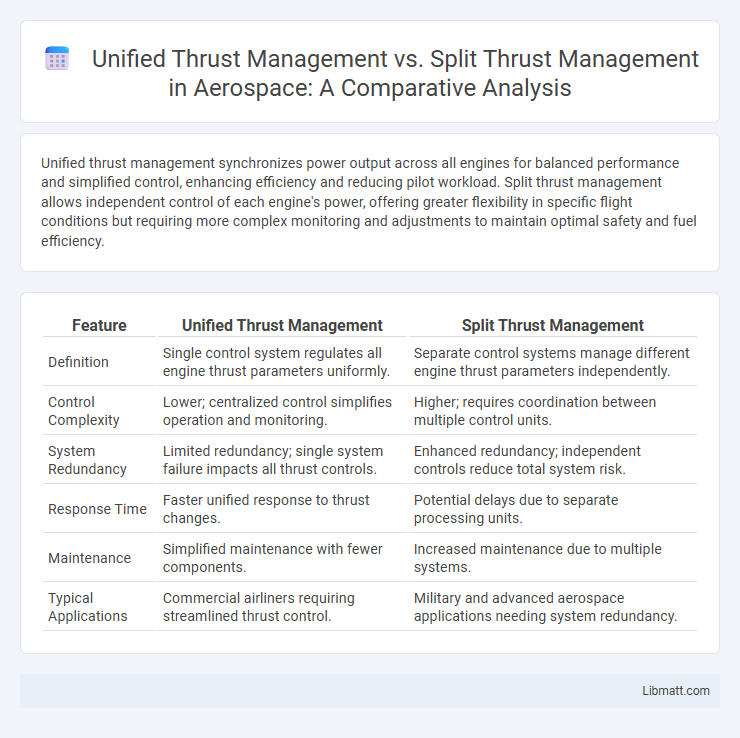Unified thrust management synchronizes power output across all engines for balanced performance and simplified control, enhancing efficiency and reducing pilot workload. Split thrust management allows independent control of each engine's power, offering greater flexibility in specific flight conditions but requiring more complex monitoring and adjustments to maintain optimal safety and fuel efficiency.
Table of Comparison
| Feature | Unified Thrust Management | Split Thrust Management |
|---|---|---|
| Definition | Single control system regulates all engine thrust parameters uniformly. | Separate control systems manage different engine thrust parameters independently. |
| Control Complexity | Lower; centralized control simplifies operation and monitoring. | Higher; requires coordination between multiple control units. |
| System Redundancy | Limited redundancy; single system failure impacts all thrust controls. | Enhanced redundancy; independent controls reduce total system risk. |
| Response Time | Faster unified response to thrust changes. | Potential delays due to separate processing units. |
| Maintenance | Simplified maintenance with fewer components. | Increased maintenance due to multiple systems. |
| Typical Applications | Commercial airliners requiring streamlined thrust control. | Military and advanced aerospace applications needing system redundancy. |
Introduction to Thrust Management in Aviation
Thrust management in aviation involves controlling engine power to optimize aircraft performance, fuel efficiency, and safety throughout various phases of flight. Unified thrust management integrates engine controls into a single system, allowing synchronized adjustments across all engines, enhancing operational precision and reducing pilot workload. Split thrust management separates controls for each engine, offering independent power settings but increasing complexity and pilot input requirements during flight operations.
Defining Unified Thrust Management
Unified thrust management integrates the control of all engine thrust levels into a single system, allowing synchronized adjustments for enhanced efficiency and simplified pilot input. Split thrust management, in contrast, independently controls each engine's thrust, offering flexibility but increasing pilot workload. Your choice depends on aircraft type and operational priorities, with unified systems commonly used in modern commercial jets for streamlined performance.
Understanding Split Thrust Management
Split Thrust Management allows independent control of each engine's thrust, enhancing maneuverability and enabling more precise adjustments during critical flight phases such as takeoff and landing. This method improves safety and fuel efficiency by optimizing power distribution based on individual engine performance and environmental conditions. Understanding how Split Thrust Management works helps you better appreciate advanced cockpit systems designed to maximize aircraft responsiveness and operational flexibility.
Key Differences Between Unified and Split Thrust Approaches
Unified thrust management centralizes control by synchronizing all engine thrust outputs to operate in harmony, increasing efficiency and reducing pilot workload. Split thrust management allows independent control of each engine's thrust, enhancing maneuverability and providing better response during asymmetric thrust situations. Key differences revolve around control complexity, operational flexibility, and system integration, with unified systems favoring simplicity and split systems emphasizing precision and adaptability.
Operational Efficiency: Unified vs Split Thrust Systems
Unified thrust management systems enhance operational efficiency by allowing synchronized control of all engines, reducing pilot workload and improving fuel consumption during critical flight phases. In contrast, split thrust management requires independent engine control, increasing complexity and response times, which can lead to higher operational costs and increased pilot fatigue. Airlines benefit from unified systems through streamlined operations and optimized engine performance, translating to better overall aircraft efficiency.
Safety Considerations in Thrust Management Methods
Unified thrust management enhances safety by synchronizing engine outputs, reducing asymmetrical thrust risks and minimizing pilot workload during critical phases like takeoff and landing. Split thrust management allows independent engine control, providing greater flexibility but increasing the potential for pilot error and asymmetric thrust scenarios that can compromise aircraft stability. Advanced flight control systems mitigate risks in both methods, but unified systems generally offer more reliable safety margins under high-stress conditions.
Applications in Modern Aircraft Design
Unified thrust management integrates engine control systems to optimize performance and fuel efficiency, widely adopted in commercial airliners such as the Boeing 787 and Airbus A350. Split thrust management separates control between the engine's core and fan thrust, often used in military and aerobatic aircraft for enhanced maneuverability and response. Modern aircraft design prioritizes unified systems for operational cost savings and environmental compliance while retaining split systems in applications requiring precise propulsion control.
Impact on Pilot Workload and Training
Unified thrust management reduces pilot workload by simplifying engine control inputs, allowing pilots to adjust all engine thrust simultaneously with a single command. Split thrust management demands higher pilot skill and increased attention, as each engine's thrust must be managed independently, elevating training complexity and operational vigilance. Your training programs must address these differences to ensure pilots are proficient in managing the specific thrust system used in their aircraft.
Maintenance and Reliability Factors
Unified thrust management systems typically require less maintenance due to their integrated design, which reduces the number of moving parts and potential failure points, enhancing overall reliability. Split thrust management involves separate controls for each engine, increasing complexity and the likelihood of component wear, thereby raising maintenance demands. The streamlined architecture of unified systems promotes consistent performance and reduces downtime, whereas split systems may necessitate more frequent inspections and repairs to ensure synchronized engine operation.
Future Trends in Thrust Management Technologies
Unified thrust management systems streamline engine control by integrating multiple engine parameters into a single interface, enhancing efficiency and reducing pilot workload. Future trends in thrust management technologies emphasize increased automation, AI-driven predictive maintenance, and adaptive thrust control to optimize fuel consumption and emissions reduction. You can expect these advancements to improve overall aircraft performance and safety while supporting sustainable aviation initiatives.
Unified thrust management vs Split thrust management Infographic

 libmatt.com
libmatt.com